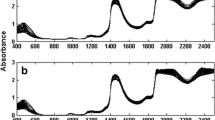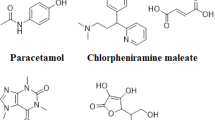Abstract
A fast and reliable spectroscopic method for multicomponent quantitative analysis of targeted compounds with overlapping signals in complex mixtures has been established. The innovative analytical approach is based on the preliminary chemometric extraction of qualitative and quantitative information from UV–vis and IR spectral profiles of a calibration system using independent component analysis (ICA). Using this quantitative model and ICA resolution results of spectral profiling of “unknown” model mixtures, the absolute analyte concentrations in multicomponent mixtures and authentic samples were then calculated without reference solutions. Good recoveries generally between 95% and 105% were obtained. The method can be applied to any spectroscopic data that obey the Beer–Lambert–Bouguer law. The proposed method was tested on analysis of vitamins and caffeine in energy drinks and aromatic hydrocarbons in motor fuel with 10% error. The results demonstrated that the proposed method is a promising tool for rapid simultaneous multicomponent analysis in the case of spectral overlap and the absence/inaccessibility of reference materials.





Similar content being viewed by others
References
Kumar N, Bansal A, Sarma G, Rawal RK. Chemometrics tools used in analytical chemistry: an overview. Talanta. 2014;123:186–99.
Hyvärinen A. Independent component analysis: recent advances. Philos Trans R Soc Lond A. 2013;371:20110534. doi:10.1098/rsta.2011.0534.
Rutledge DN, Jouan-Rimbaud Bouveresse D. Independent components analysis with the JADE algorithm. Trends Anal Chem. 2013;50:22–32.
Golshan A, Abdollahi H, Beyramysoltan S, et al. A review of recent methods for the determination of ranges of feasible solutions resulting from soft modelling analyses of multivariate data. Anal Chim Acta. 2016;911:1–13.
de Juan A, Tauler RÃ. Multivariate curve resolution (MCR) from 2000: progress in concepts and applications. Crit Rev Anal Chem. 2006;36(3–4):163–76.
Ruckebusch C, Blanchet L. Multivariate curve resolution: a review of advanced and tailored applications and challenges. Anal Chim Acta. 2013;65:28–36.
Wold S, Sjöström M, Eriksson L. PLS-regression: a basic tool of chemometrics. Chemom Intell Lab Syst. 2001;58:109–30.
Monakhova YB, Astakhov SA, Kraskov A, Mushtakova SP. Independent components in spectroscopic analysis of complex mixtures. Chemom Intell Lab Syst. 2010;103:108–15.
Monakhova YB, Mushtakova SP, Kolesnikova SS, Astakhov SA. Chemometrics-assisted spectrophotometric method for simultaneous determination of vitamins in complex mixtures. Anal Bioanal Chem. 2010;397:1297–306.
Monakhova YB, Tsikin AM, Kuballa T, Lachenmeier DW, Mushtakova SP. Independent component analysis (ICA) algorithms for improved spectral deconvolution of overlapped signals in 1H NMR analysis: application to foods and related products. Magn Reson Chem. 2014;52(5):231–40.
Kassouf A, Ruellan A, Jouan-Rimbaud Bouveresse D, et al. Attenuated total reflectance-mid infrared spectroscopy (ATR-MIR) coupled with independent components analysis (ICA): A fast method to determine plasticizers in polylactide (PLA). Talanta. 2016;147:569–80.
Ammari F, Redjdal L, Rutledge DN. Detection of orange juice frauds using front-face fluorescence spectroscopy and independent components analysis. Food Chem. 2015;168:211–7.
Monakhova YB, Lachenmeier DW, Kuballa T, Mushtakova SP. Standardless multicomponent qNMR analysis of compounds with overlapped resonances based on the combination of ICA and PULCON. Magn Reson Chem. 2015;53:821–8.
Wider G, Dreier L. Measuring protein concentrations by NMR spectroscopy. J Am Chem Soc. 2006;128(8):2571–6.
Stögbauer H, Kraskov A, Astakhov SA, Grassberger P. Least-dependent-component analysis based on mutual information. Phys Rev E. 2004;70:066123.
Monakhova YB, Mushtakova SP. Mathematical spectra pretreatment for independent component analysis: identification and quantitative analysis. J Anal Chem. 2012;67:1044–51.
Monakhova YB, Tsikin AM, Mushtakova SP. Independent components analysis as an alternative to principal component analysis and discriminant analysis algorithms in the processing of spectrometric data. J Anal Chem. 2015;70:1055–61.
Monakhova YB, Rutledge DN, Roßmann A, et al. Determination of rice type by 1H NMR spectroscopy in combination with different chemometric tools. J Chemom. 2014;28:83–92.
Chen J, Wang XZ. A new approach to near-infrared spectral data analysis using independent component analysis. J Chem Inf Model. 2001;41:992–1001.
Zhao C, Gao F. Multiset independent component regression (MsICR) based statistical data analysis and calibration modeling. Ind Eng Chem Res. 2013;52:2917–24.
Shao X, Wang W, Houa Z, Cai W. A new regression method based on independent component analysis. Talanta. 2006;69:676–80.
Domingo-Almenara X, Perera A, Ramírez N, Cañellas N, Correig X, Brezmes J. J Chromatogr A. 2015;1409:226–33.
Al-Mbaideen A, Benaissa M. Determination of glucose concentration from NIR spectra using independent component regression. Chemom Intell Lab Syst. 2011;105:131–5.
Kaneko H, Arakawa M, Funatsu K. Development of a new regression analysis method using independent component analysis. J Chem Inf Model. 2008;48:534–41.
Gustafsson MG. Independent component analysis yields chemically interpretable latent variables in multivariate regression. J Chem Inf Model. 2005;45:1244–55.
Wang G, Ding Q, Hou Z. Independent component analysis and its applications in signal processing for analytical chemistry. Trends Anal Chem. 2008;27:368–76.
Acknowledgements
Y.B.M. acknowledges funding in the framework of the Russian President’s Grant for Young Scientists (MK-6226.2016.3).
Author information
Authors and Affiliations
Corresponding author
Ethics declarations
Conflict of interest
The authors declare that they have no conflict of interest.
Rights and permissions
About this article
Cite this article
Monakhova, Y.B., Mushtakova, S.P. Multicomponent quantitative spectroscopic analysis without reference substances based on ICA modelling. Anal Bioanal Chem 409, 3319–3327 (2017). https://doi.org/10.1007/s00216-017-0275-0
Received:
Revised:
Accepted:
Published:
Issue Date:
DOI: https://doi.org/10.1007/s00216-017-0275-0




